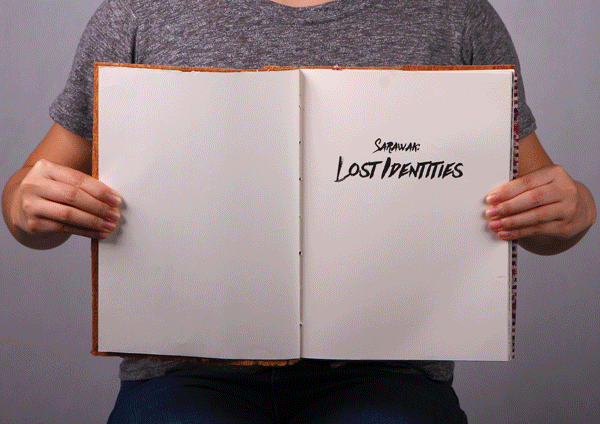Sarawak: The Lost Identities
The Land of Hornbills has a diverse range of cultures, with at least 45 recognized ethnic groups, each with its own unique traits that differentiate them from the rest. Every individual connects and identifies themselves with their own set of cultural rules. As human beings, we feel the need to belong - this is a statement that should never be taken too lightly.
As urbanization kicks in, lost cultures being mended becomes a debatable topic; the dilemma of moving on forward towards a modern world or going back to living in the dark forests. The question is, how much time do we have left to record this precious heritage, before too little remains to be remembered?
Q and A Interview with Marcos Kueh
Website: www.behance.net/zepharox
Email Address: marcos_3063@hotmail.my
B: Borneo Art Collective M: Marcos Kueh
B: Could you describe the selected project in brief?
M: This is a project that I've completed for my editorial class with the theme "Malaysian Culture".
The project brief required us to produce a book of not less than 25 pages with a proper categorising system that portrays what Malaysian Culture is about within the 14 weeks deadline.
The 105 page book is hand-stitched and has six chapters, each talking about the background of the major races that roam the lands of Sarawak, complete with hand-drawn illustrations and photos for the viewers to better visualize the information.
The cover of the book is a special type of material made from the bark of a sago tree, sourced from the Bidayuhs. A Pua Kumbu, the traditional textile of the Ibans, is included as a bookmark for the book.
B: Why and how did you start this project?
M: I was encouraged to venture into a topic that is true to who I am as a Malaysian when planning for the concept of the project.
How local media portrays Malaysia to be a multi-cultural land of the Malays, Chinese and Indians has long been something that bothers me. When I started my college years in West Malaysia, I was surprised by how big the difference was between the east and west even if we're the same country. I knew then that my version of Malaysian Culture was never meant to be "the old streets of Petaling" or "Sentul flavours". It's just not meant to be.
I felt that as a Sarawakian, there was a need to break the stereotype and notion that Sarawak is just full of trees. Culturally, the local natives do deserve equal attention, respect as one country and more exposure.
B: Who/what influenceed you to begin this project?
M: My homeland, Sarawak.
As mentioned, I was really culturally shocked when I first ventured into West Malaysia (Semenanjung). I hope that through my project I can bridge the gap between the Borneo and Semenanjung, to let people see that Malaysian culture is this really big diverse spectrum that we can really take pride in.
B: What was on your radar when you were creating this project ?
M: I had minimal idea about the ethic groups in Sarawak when I started this project, even to the point of being skeptical of producing a book on such a heavy topic in such a short amount of time. I took the chance, made up my mind and took one weekend to travel back home to collect as much data as I could.
I think it was through the process of crafting this book that I learnt more about myself and where I come from. Sometimes as Designers you really need to indulge yourself in the design process and not limit yourself. All that was on my radar was the passion to share and understand where I come from.
B: Where do you see yourself or your project evolving in the near future?
M: I was pleasantly surprised that my project has gained much interest from my course mates, juniors and seniors alike, as many West Malaysians have never ventured into our lands and have no concept of what the culture there is like. In a way you could feel the difference in appreciation of the book between West Malaysians and East Malaysians. People from my hometown would take pride in projects like these while West Malaysians really appreciate getting to know a different side of Malaysia.
I hope that from here, I can generate more interest and exposure to our land, to her beauty and later on to her issues. I am really interested in community design as I believe that through visual communication, there is potential to make a big impact to the community as visual communication can be understood very effectively, especially in a really diverse country such as Sarawak.
To be able to experiment and translate Sarawakian culture into design and represent my homeland on the international level is a possible goal that came about through the process of crafting this book.
B: How do you see Borneo Art at the moment?
M: It is a box full of treasures that has always been there but has always overlooked. Documentation of the movement has been very limited and preservation efforts are not happening.
For people who appreciate it, it could be something very exciting - as no one has set down a standard of what Borneo Art is, there could be something very original waiting to be uncovered for the rest of the world to see. Further experimentation, documentation and development is desperately needed.
B: Please recommend three stories/projects/individuals/groups that we should reach out to in order to expanding the Borneo Art Collective network.
M: The Tun Jugah Foundation has a good collection of precious resources focusing on the preservation of the Iban cultures. The workers of the Cultural Village in Santubong always have stories to tell, and last but not least, there's so much to dig through and uncover in the many antique shops of Carpenter street.























![Testimonials: Pan Borneo Road Trip [Artists]](https://images.squarespace-cdn.com/content/v1/56dca44804426203948c0aa7/1484237132604-6HTBYHZTMSGAT1D5K797/15272064_10209687841611346_7561095113811853538_o.jpg)
![Testimonials: Pan Borneo Road Trip [Core Members]](https://images.squarespace-cdn.com/content/v1/56dca44804426203948c0aa7/1484238039478-49P3JZ86LY9B0BL3INY7/unnamed.jpg)